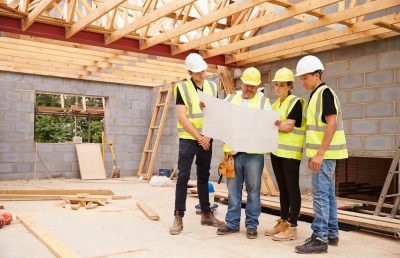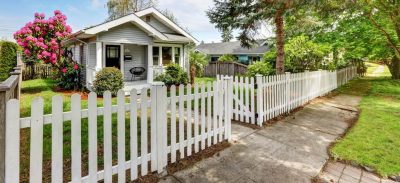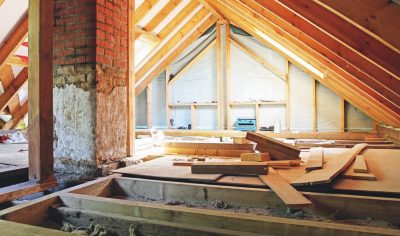- Oneflare /
- Cost Guides /
- Decking

How much does a deck cost in 2023?
$2,300 - $4,500
What's on this page
- Cost of hiring a decking expert
- Overview of Common Decking Materials
- Setting a budget for your decking
- Factors affecting decking costs
- Decking Posts and Stumps
- How to hire a decking expert
Read Related Decking Articles
Cost of hiring a decking expect
Decking professionals have the ability to create inviting, comfortable and cosy outdoor living and entertaining areas. Besides getting ideas for the perfect deck, hiring the right professional is an essential step to ensuring correct installation and maintenance for a long-lasting outdoor solution.
The cost of your decking professional will depend on the material you decide to use, how large the deck is and whether it needs building, repairing or replacing altogether.
| Services available | Installation, repair, maintenance |
|---|---|
| Certification required | No |
| Verified businesses | Yes |
| Free quotes available | 3 |
| Online or in-person | In-person |
| Average repair cost | $1,700 – $3,100 |
| Average installation cost | $3,300 – $6,500 |
| Average replacement cost | $2,100 – $3,800 |
Installation costs in Australia
Decking costs vary slightly between cities. Many factors affect the overall cost of decking in Australia such as the size of the deck, the material used and the complexity of the design. See the below table for an average price range between cities.
| City | Average reported costs |
|---|---|
| Sydney | $1,000 – $3,000 |
| Melbourne | $1,000 – $3,500 |
| Canberra | $1,500 – $2,000 |
| Perth | $1,000 – $3,000 |
Overview of Common Decking Materials
Timber is commonly used for decking and is available in various forms, including treated pine, cypress, and hardwood timber decking, such as Merbau and Kwila. Other materials, such as composite and plastic, offer durability and low maintenance.
140×45 Treated Pine Decking Span: This is a popular choice for decking, suitable for residential and commercial projects. It’s a cost-effective option, has high durability, and provides excellent dimensional stability. Treated pine is resistant to decay and insect damage, making it long-lasting. It is essential to ensure that the timber grade meets the MGP10 span tables specifications.
90×90 Treated Pine Masters: Using this is essential for building a substantial deck. The masters provide structural support and help to distribute the weight of the deck evenly. They are installed perpendicular to the joists and provide vertical support for a solid and strong deck.
Treated Pine Posts: These are an essential component for constructing a substantial and secure deck. These posts are installed in concrete footings and provide the necessary support for the deck. It’s essential to ensure that treated pine posts are installed correctly to avoid post rotation and guarantee their longevity.
100×100 Cypress Post: This is an excellent alternative to treated pine. Cypress timber is naturally termite-resistant and durable in outdoor conditions. Cypress posts offer better resistance to decay and rot than treated pine, making them a long-lasting option for decking.
Lime Wash Cypress Pine Flooring: This provides an attractive and natural finish for decking. It’s naturally resistant to decay, insect damage, and rot. Additionally, lime wash cypress pine flooring is easy to maintain and can last for years with proper care.
Setting a budget for your decking
When setting a budget for your decking job, it’s important to know that there are three main services: installation, repair, and replacement. While this is the main factor that will affect how much you spend to get the job done, other factors will come into play, such as the condition of your existing deck or the material used to build the old or new one.
Deck installation cost- $3,300 – $6,500 average reported cost
The expected cost to build a deck does not vary greatly from the installation of a new deck completely. However, the main determinant of the price quoted for your repair job will be to what extent the deck is damaged, as well as the material potentially having an effect too.
Deck repair costs- $1700 – $3100 average reported cost
The expected cost to be paid does not vary greatly from the installation of a new deck completely. However, the main determinant of the price quoted for your repair job will be to what extent the deck is damaged, as well as the material potentially having an effect too.
Deck replacement cost – $2,100 – $3,800 average reported cost
Out of the three, a replacement of your decking will be the most expensive. This is mainly because the decking professional will have to remove the existing decking and build a new one from scratch, which will add a great number of labour hours.
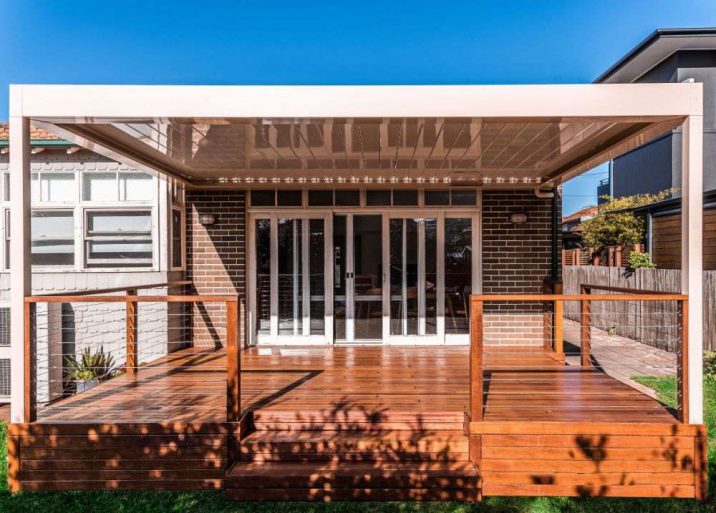
Timber decking with steel pergola. | Source: Lunar Constructions
Other factors affecting the costs of the job
While the type of service required will be the first factor that comes into play when pricing your decking job, other factors such as size and material will have a substantial effect. Here are estimates of how much a deck costs within Australia, so you know what to expect.
Size of the project
The larger the project, the larger the decking cost per square metre. The size of the deck will also determine whether or not you need to seek council approval before you build. Waiting for approval can delay a project.
As the allowances for deck size vary from council to council you will need to check with your local council as to whether the size you are looking to have installed requires approval or not.
| Decking size | Average reported cost |
| 10m² | $3,700 – $5,500 |
| 20m² | $3,900 – $5,200 |
| 30m² | $4,000 – $6,900 |
| 40m² | $4,900 – $7,100 |
| 50m² | $5,200 – $11,000+ |
Decking material
The type you choose will also have a significant impact on the cost of your timber deck. It is crucial to consider your timber options here. Cheaper materials such as pine may be attractive initially, but they may require extra maintenance in the long run as opposed to Merbau (which is a lot harder wearing and just as sustainable).
The material used can range from treated pine sleeper decking to Hardie deck, which is a popular alternative made of fiber cement. While treated pine is cheaper, Hardie deck is more expensive but also more durable and low-maintenance. Additionally, Knotwood is another popular option which has an attractive wood-like appearance but is made of aluminium.
| Decking material | Average reported cost (per square metre) |
|---|---|
| Pine | $150 – $250 |
| Merbau | $250 – $350 |
| Composite Deck | $300 – $400 |
| Timber | $250 – $350 |
| Modwood | $300 – $400 |
| Spotted Gum | $100 – $150 |
| Blackbutt | $75 – $150 |
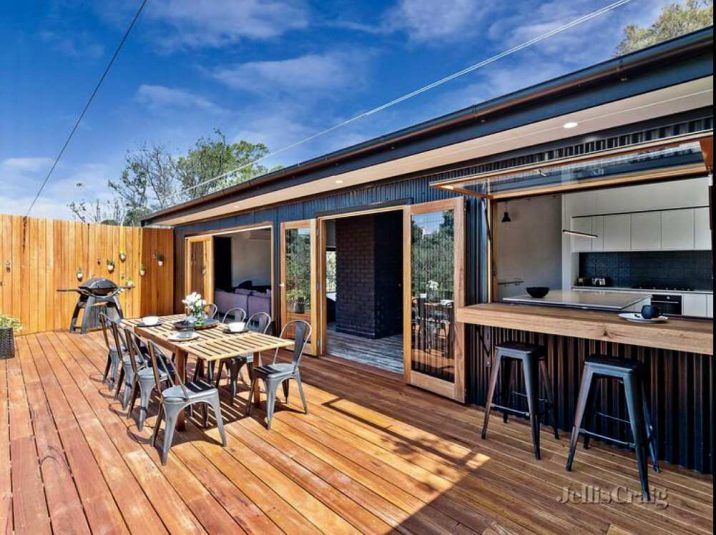
The use of decking as an entertainment area. | Source: chrome projects
Accessories and features
While the decking material and size of the project will affect the price the most, accessories and features will also affect the total price. Accessories include any nuts, bolts, and posts involved in building the deck, as well as the timber for bearers and joists, and the inclusion of these materials will drive the price up – but it shouldn’t be a substantial proportion of the cost of the project.
The absence or addition of features can affect the price quoted directly, such as if you require stairs, a balustrade, any roofing or if the deck is elevated. If you decide to elevate your deck, this will drive the price in an upward direction as it is more labour intensive for the professional and has to adhere to strict specifications.
Various accessories such as Protector Deck, KlevaKlip, and outdoor plasterboard can add to the cost of building a deck. KlevaKlip, for instance, is a popular option that allows for easy installation of decking boards without the need for screws or nails. Similarly, outdoor plasterboard can be used to create an attractive and waterproof ceiling under the deck.
It is important to note that a decking quote will factor in most of these prices. Be sure to also consider labour costs that may also be associated with the construction of a deck.
Decking Bearers and Joists
The size and material of the bearers and joists will affect the overall cost of your deck. The required bearer span will depend on the type of timber used, the distance between the bearers, and the load they will be supporting. MGP10 and H3 treated pine are popular choices for decking bearers, and their span tables should be consulted to ensure the correct bearer span is used.
Installation Method
The installation method used will also affect the cost of building a deck. For example, using a nail gun or speed deck tool can save time and labor costs, but these tools also require a certain level of skill to use effectively. Another alternative is using Pryda screws, which are specifically designed for decking installations.
Verandah Beams and C Purlins
If you are building a deck as an extension of your verandah, the cost will be higher due to the need for verandah beams and C purlins. The type and size of these structural elements will depend on the design of your deck and verandah.
By considering these factors, you can get a more accurate estimate of the cost of building your dream deck. Remember to consult with your local hardware store or a professional builder to ensure that you are using the correct materials and methods for your specific needs.
Decking Posts and Stumps
Decking posts and stumps are essential components of any deck as they provide the structural support needed to ensure the deck is stable and safe. When planning your deck, it’s important to consider the decking regulations in your area, as these may impact the size and spacing of your posts and stumps. In Victoria, for instance, there are specific regulations regarding the use of stumps and their spacing.
Decking Posts
Decking posts can be made of various materials such as timber, steel, or concrete. Timber posts are a popular choice as they are affordable and easy to work with. Steel deck posts are also becoming increasingly popular due to their durability and low maintenance requirements. When selecting decking posts, it’s important to consider the load they will be supporting and ensure they are strong enough to bear the weight of the deck.
Decking Stumps
Decking stumps are used to support the posts and are typically made of timber or concrete. In Victoria, the regulations specify that stumps must be spaced no more than 1.5 meters apart, and the size of the stumps will depend on the load they are supporting. For example, a deck with a load of 1.5 kPa will require stumps that are at least 150 x 150 mm in size.
Decking Posts and Stumps at Bunnings
If you’re looking for decking posts and stumps, Bunnings is a great place to start. They offer a range of options in various sizes and materials, including treated pine and steel. When selecting posts and stumps from Bunnings, ensure that they meet the decking regulations in your area and are appropriate for the size and load of your deck.
By considering the decking regulations in your area and selecting the appropriate posts and stumps, you can ensure that your deck is structurally sound and safe for use. Remember to consult with a professional builder or engineer if you have any doubts or concerns about the design and construction of your deck.
How to hire a decking expert
Reviews: Reading customer reviews on the business’s Oneflare profile are effective in indicating if the business possesses professionalism, is on-time and is capable of completing a quality decking job
Licencing: Depending on where you live you will need to make sure that your chosen deck builder is properly licenced. It varies state to state as to whether the business you hire needs to be classed as either a carpenter or a builder. If in doubt, check with your local council on any regulations you will need to adhere to
If they have the verified badge on their Oneflare profile, this means they have provided an ABN and are a legitimate business.
* The cost data is based on Oneflare and third-party sources
Real Oneflare Customer Quotes
Peggy's Decking Job
Decking service
Building a new deck
Material
Composite
Size of deck
25m²
$240inc. gst
Quoted by Archi Building Group Pty Ltd
Stephan's Decking Job
Decking service
Building a new deck
Location of deck
Backyard
Size of deck
15m²
$2700inc. gst
Quoted by CPLS Carpentry
Clinton's Decking Job
Decking service
Installation of boards
Details
Replace treated pine with spotted gum
Size of area
30m²
$750inc. gst
Quoted by Elwood Carpentry & Construction
